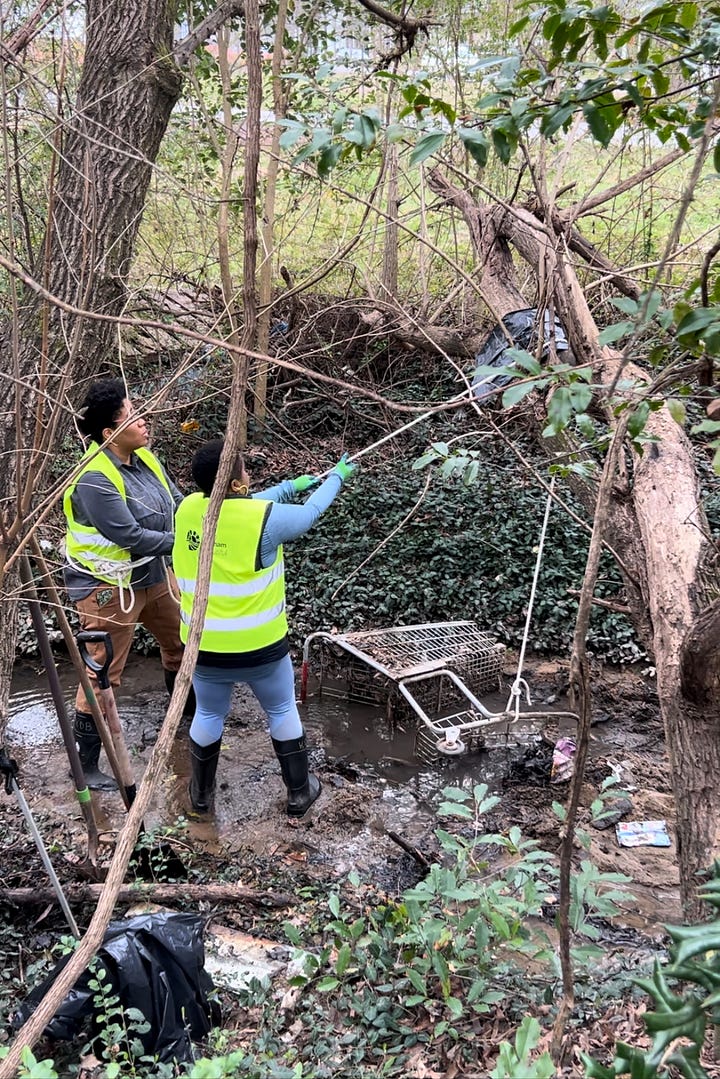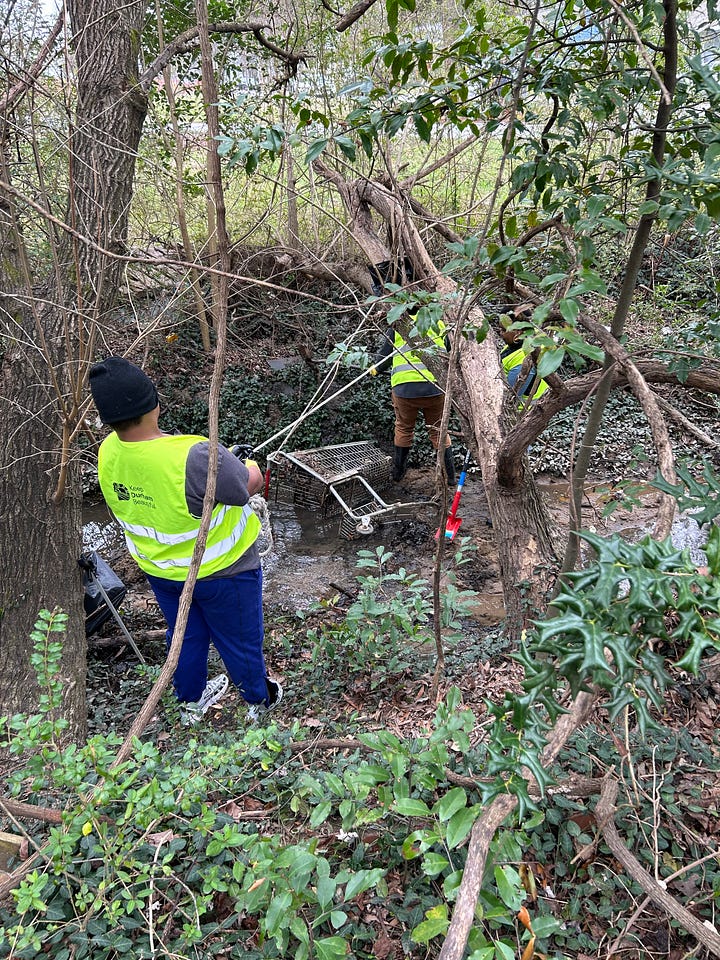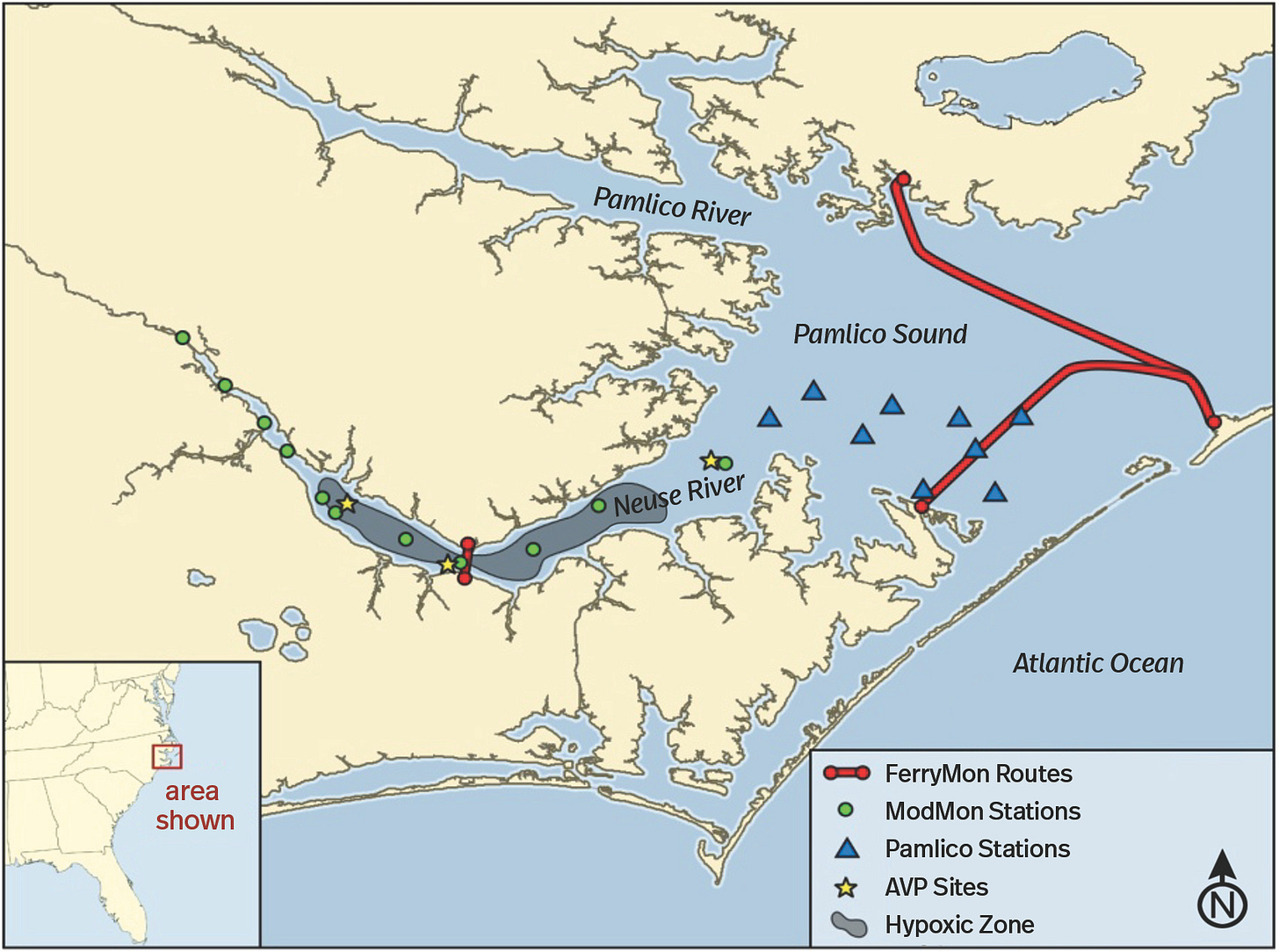AfroCarolina Correspondence #315: Creek Week
From East Durham to Eastern NC, The Waterways Connect Us All
“The sea brought you here, the sea will bring you home”1
The two pink magnolia trees in front of the small West African church, about four doors down from my home in East Durham, quietly alerted us all this past week that spring has arrived. The vibrant, almost fuchsia buds began to blossom almost overnight, which offered a burst of delight in the midst of an otherwise dreary week. This colorful message from mother nature and a bit of internal restlessness prompted me from my roost and on a walk halfway down the block to visit with my neighbor, Nia.
During our conversation, Nia invited me to a neighborhood clean up of the creek that runs through our block. Despite my appreciation of creeks, runs, rivers and other smaller bodies of water, I hadn’t paid much attention to the one that was in my own neighborhood. It was usually littered with trash and obscured by overgrown vines and weeds, so during my walks, I often glanced at it with grief and discomfort, mentally imploring the city to come clean it up. Because of the steep, muddy incline leading to the water and generally treacherous conditions, I hadn’t thought it possible to clean it up without municipal resources until talking with Nia.
The following Saturday morning, I trekked down the hill from my house towards the creek. As I approached, I saw a gaggle of folks in neon vests heading towards the side I was familiar with, and another going towards the opposite side of the street where there was another entrance to the creek that I hadn’t noticed before. There was a small table set up in the parking lot of the daycare center beside the creek. It held a few boxes of bojangles biscuits, a carton of dunkin donuts coffee, and some snacks. Nia had enlisted the support of Keep Durham Beautiful, a local environmental organization, who had sent one of their representatives, a sprightly white woman named Courtney, and a trunk full of supplies to support our clean up.
As I munched on a biscuit, Courtney equipped me with a vest, gloves, and a trash bag. She explained that it was Creek Week, so they didn’t have quite as many supplies available because there were similar clean up events happening throughout the city2. During my brief orientation, she also explained that we were situated along Ellerbe Creek. It had never occurred to me that the shallow, obscured area that seemed to hold more plastic than water would have a name. Furthermore, she shared that Ellerbe Creek feeds into the Neuse River which then feeds into the Albemarle/PamlicoWatershed leading straight to the Atlantic Ocean.
I could barely contain my delight at realizing I was living along a creek that was directly connected to the waterways of my maternal homelands in Eastern NC. I had previously lived with my maternal grandmother in Greenville, NC and during that season, most mornings were punctuated by a walk along the Tar River. This daily ritual became an apprenticeship of sorts with the land of my maternal line. I would walk the river trail, studying the plants that grew along the riverbank, making note of their medicinal qualities. I had a few spots closer to the water, off the trail, where I meditated, prayed, and watched all sorts of wildlife emerge to remind me that I, too, am a part of the natural world. I occasionally made the 30 minute drive to Little Washington, the home of my Great Great Grandma Roena, where the Tar River becomes the Pamlico- a well documented alleyway on the fugitive escape route during enslavement.
Since moving back to Durham, I’ve often lamented the fact that I wasn’t closer to the rivers that have held me and my folks. And now, here I was being told that the little creek just a few houses down from me was feeding right into those rivers. I contemplated that revelation for quite a while as I joined the others, filling my trash bag with plastic bottles, bags and other miscellaneous items.
Our main triumph of the day was removing a walgreens shopping cart that had been entrenched in the creek, weighed down by layers of trash and mucky sand for months. Sarah and Danielle, two members of our small but mighty crew, had adorned some of the knee high rubber boots supplied by Courtney, and were ankle deep in the water trying to pull the cart out. They even devised a makeshift pulley system out of rope to try and lift the cart out to no avail. It wasn’t until my teenage neighbor, Daryl, rode by on his bicycle and decided to join, that we were finally able to pull the cart out of the creek.


We celebrated by taking a picture in front of the mound of trash we’d collected from our little section of what’s known as the most polluted creek in the Triangle. We talked about our next clean up day as we packed up. I felt a renewed sense of responsibility for the creek I’d largely ignored for the past year. If anything, Nia’s clean up day was a reminder to me that all waterways are connected; and it’s impossible to separate ourselves (and our wellbeing) to that of even the smallest of creeks.
This is a quote from the How We Be Free: Black Fugitive Study Kit created by Jessica Valoris






Alexis, the connection of the waterways and heritage is really neat. Your storytelling creates a warmth to readers. I felt like I was right there supporting the clean up efforts. Thank you for continuing to share!